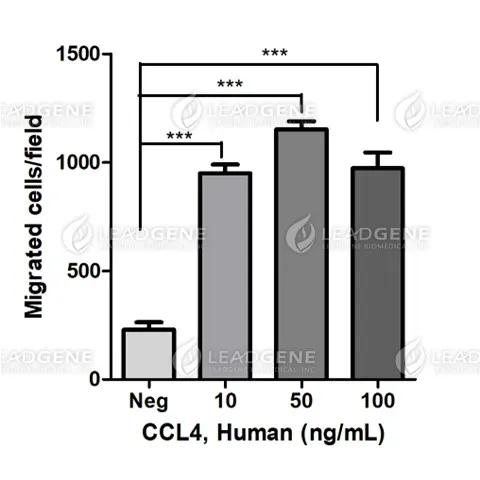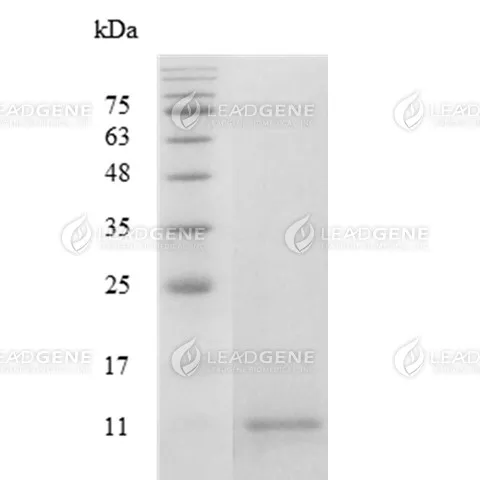-
Species of Origin
Human
Expression system
Escherichia coli
-
Affinity Tag
Tag Free
Buffer
Lyophilized from a 0.2 µm filtered solution containing 50 mM Tris and 150 mM NaCl, pH 8.5.
-
Purity
>98% as determined by SDS-PAGE analysis.
Molecular weight
The protein has a calculated MW of 7.75 kDa.
The protein migrates as 11 kDa under reducing condition (SDS-PAGE analysis). -
Activity
Measure by its ability to chemoattract human THP1 cells using a concentration range of 10-100 ng/mL.
Activity analysis of recombinant Human CCL4, Tag Free, E. coli.Endotoxin level
<0.1 EU per 1 μg of the protein by the LAL method.
-
Form
Lyophilized
-
Specifications
-
Background
-
Background
C-C Motif Chemokine Ligand 4 (CCL4) is a 7.66 kDa cytokine with 69 amino acid residues. CCL4, also named macrophage inflammatory protein-1β (MIP-1β), is mainly secreted from neutrophils, monocytes, B cells, T cells, fibroblasts, endothelial cells and epithelial cells. CCL4 recruits various immune cells like natural killer cells, monocytes, and neutrophils when CCL4 binds to CCR5. In addition, CCL4 mediates lymphocyte adhesion by Rac1 /Cdc42 signaling pathway and plays critical roles in different biological functions like maintenance of cell polarity, regulation of calcium ion transport and response to viruses.
Synonyms
Lymphocyte activation gene 1 protein, LAG-1, Macrophage inflammatory protein 1-beta, MIP-1-beta, Monocyte adherence-induced protein 5-alpha, Small-inducible cytokine A4-like, C-C motif chemokine 4-like
-
Uniprot ID
#P13236
Sequence Note
Ala24-Asn92
-
-
Instruction
-
Reconstitution
It is recommended to reconstitute the lyophilized protein in sterile H₂O to a concentration not less than 200 μg/mL and incubate the stock solution for at least 20 min to ensure sufficient re-dissolved.
Shipping
The product is shipped with polar packs. Upon receipt, store it immediately at -20°C or lower for long term storage.
-
Stability & Storage
This product is stable after storage at:
- -20°C for 12 months in lyophilized state from date of receipt.
- -20°C or -80°C for 1 month under sterile conditions after reconstitution.
Avoid repeated freeze/thaw cycles.
-
-
Image
1/2 -
Review

Help others learn more about this product. Use the link below to share your experience.
-
Publication

There are currently no publications. Use the link below to let us know.
-
Datasheet & Documents
1/1
Disclaimer:For Research Use or Further Manufacturing Only.


